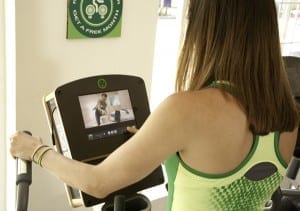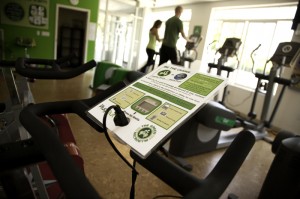
“A Workout is a Terrible Thing to Waste” — the slogan coined by The Green Microgym, a club located in Portland, Ore., and one of the first “green” gyms to open in the U.S.
Created by Adam Boesel, the owner and founder, in September 2008, its mission has been to offer Portland’s community an environmentally sustainable club where they could improve their fitness with limited energy being wasted.
A huge hit in the local community, Boesel didn’t realize until after opening that the idea of a green gym would be so successful. Community members flocked from around the surrounding area on bikes, in cars and often on their own two feet, to take part in Boesel’s unique, eco-fitness philosophy. “We have an energy-saving culture,” he said. “Our members are paying close attention, so if we slip up, they let us know.”
Just like any new club owner, Boesel faced certain struggles in the beginning that he had to overcome to see his dream come into fruition. One of those struggles was finding the energy-harnessing technology that he had envisioned when first developing The Green Microgym. “When I started the gym I thought I’d be able to partner with someone who’d be able to supply the green equipment, but there really was nothing that would work for me at the time,” he said. Determined to stick to his vision, Boesel did his own research and, through trial and error, developed a grid-tied “Plugout Cycle” — his own invention.

The Plugout Cycle, attached to the gym’s elliptical machines and cycling equipment through zip ties and a plug, shows members how many watts they are creating. That energy is used to help power the gym. Along with energy-harnessing technology, The Green Microgym is continually searching for new ways to lower the gym’s overall carbon footprint. “We’ve stumbled across a lot of interesting ways to stay green,” said Boesel.
For example, through experiments, Boesel found that by maximizing a treadmill’s incline, you could decrease the amount of electricity used by 50 percent. “We take special attention to making sure the club is as green as possible,” said Boesel. Through another experiment, Boesel found that using iPads versus TVs can be another way for clubs to save energy — iPads use significantly less energy than even energy-saving TVs.
It’s efforts like these, to constantly be more sustainable, that speak out to the Portland community. “People feel like they’re part of something cool,” said Boesel. To further that sense of community, The Green Microgym hosts community-oriented events and encourages members to shop locally through its “Burn and Earn Program.” As members work out on Boesel’s energy-harnessing equipment, they earn points towards a local-rewards card (about a dollar and hour) that can be used in local businesses approved by Supportland, a Portland-based incentive company that teamed up with The Green Microgym. The Burn and Earn program gave Boesel a way to reward members for working out at his facility.
The Green Microgym now has three locations across Portland. “The real key [to our success] is that we’re just like any other neighborhood gym — we’re convenient,” said Boesol. Although convenient, Boesel keeps his members by cultivating the local community and fostering an eco-friendly environment — one of the first of its kind in the U.S. “We decided we were going to do something people were going to talk about.”
By Rachel Zabonick
Stay ahead in the fitness industry with exclusive updates!
Rachel Zabonick-Chonko is the editor-in-chief of Club Solutions Magazine. She can be reached at rachel@peakemedia.com.











